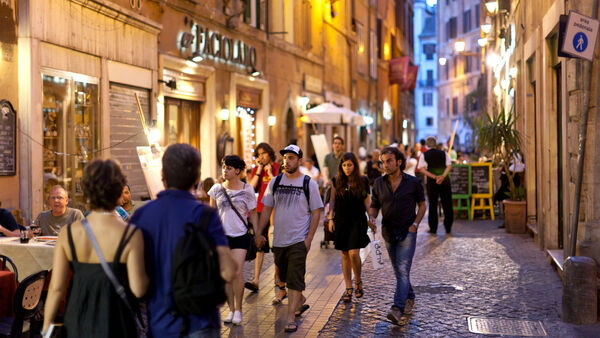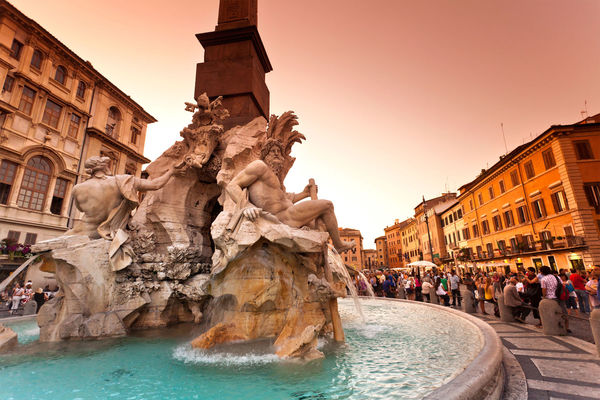A Walk Through Rome’s Living Culture
By Rick Steves

Throughout Italy, early evening is time to stroll. As I walk through the streets of the Eternal City with my Roman friends, they explain the ritual of this promenade: While elsewhere in Italy it's called the passeggiata, in Rome it's a cruder, big-city version called the struscio (which means "rub").
Unemployment among Italy's youth is very high; many young Italians live with their parents even into their 30s. They spend a lot of time being trendy and hanging out. Hard-core cruisers from the Roman suburbs, which lack pleasant public spaces, congregate on the downtown boulevard Via del Corso. The Vespa motor scooter is their symbol; haircuts and fashion are follow-the-leader.
In a more genteel small town, the passeggiata comes with sweet whispers of "bella" and "bello" ("pretty" and "handsome") as the boys and girls eye each other. But in Rome, the admiration is more strongly oriented toward consumption — they say "buona" and "buono," meaning "tasty" (terms used to describe food). Police barricades keep out the traffic as, from Piazza del Popolo down Via del Corso and up Via Condotti to the Spanish Steps, shoppers, people-watchers, chunky middle-aged Italians, and young flirts on the prowl make the scene.
In their travels, tourists are often content to "experience" the art and culture of a great city such as Rome in museums and on stage. But I strive to be engulfed in the living culture, to enjoy it "in situ" — the art-history term for "on location." You can be a spectator, sipping a drink at a sidewalk table, but it's more fun to stroll along with everyone else. It's the perfect way to start a night in Rome.
The next day, I'm immersed in an entirely different scene — jammed into St. Peter's Basilica with thousands of worshippers for Mass. As the pope circulates, the peacocks of the security world — the Vatican's fancy-garbed Swiss Guard, with their flamboyant helmets and medieval pikes shining under heavenly sunrays — are on high alert. Their darting eyes and walkie-talkie earpieces show they're there for more than ritual and decoration.
Afterward, the crowd pours like sand out of a spiritual hourglass from the basilica into St. Peter's Square. There, I join an even larger crowd that just "attended" the Mass on huge rock-concert-type video screens. It's a Catholic tailgate party, as groups from around the world — mustachioed Sicilians bellowing "Viva il papa!" to their pope, cowboy-hatted Calabrians forcing wine on strangers, and noisy Mexican teenagers screaming "Viva May-hee-ko!" — wait for their spiritual leader to appear from the window of his study overlooking the square. Suddenly, the famous window opens, the red banner flops down, and the pope appears.
After the pope finishes his short greeting, the crowd dissipates — melting back into Rome. Going with the human flow, I cross the Ponte Sant'Angelo, a bridge as old as the papacy. Pausing midstream, I remember that 200 worshippers drowned during a similar papal event in the year 1450, as the crowd surged over this bridge, knocking pilgrims into the Tiber River. I'm thankful they renovated the venerable bridge with a tall and sturdy stone railing.
I wander over to the always-thriving Piazza Navona, with its gushing Bernini fountains and famous gelateria. As usual, it's busy with families out for a stroll, street musicians, artists, fire-eaters, local Casanovas, immigrants selling the latest plastic tourist trinket, and people screwing their forefinger into their cheeks. That's the Italian sign for "yummy"…like when you're eating the tartufo chocolate ice cream treat that several of the square's cafés claim to have perfected. Piazza Navona's outdoor cafés are a worthy splurge if you've got time to sit and enjoy Italy's human river.
Around the corner, a well-worn old statue sits covered with feedback from this Roman neighborhood. This graffiti tradition goes back centuries, to times when people couldn't speak their minds but could write (anonymously) what was in their hearts.
Under a sloppy Italian flag, messages scrawled around the statue proclaim that all politicians are unhinged. Below that, someone else gripes that Rome's many pedestrian streets are causing traffic jams everywhere.
A few blocks away, the ancient Pantheon, once a Roman temple, is filled with folding chairs, people, and music — now in action as a modern-day church. Across the street, I drink coffee — a Roman art form in itself — and review a tourist-office flier with the local concert schedule. The Doria Pamphilj Villa, once home to an 18th-century art-loving duke, is hosting a chandelier-lit string quartet amid paintings by Raphael, Caravaggio, and Velázquez. I think I'll go…and enjoy more European life in situ.

